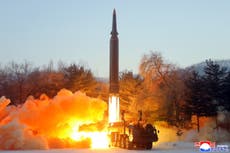Video shows masses of burning tornado debris across South Dakota in race to stop new tragedy
Some scientists suggest that tornadoes are getting stronger due to climate change
A dramatic new video reveals burning of hundreds of piles of debris in the Black Hills of South Dakota caused by recent tornadoes in the region.
Footage from the Black Hills National Forest shows the process of cleaning up dead vegetation resulting from the extreme weather events in the Spearfish area of the Black Hills, an isolated mountain range rising from the Great Plains in South Dakota and stretching into Wyoming.
The tornadoes responsible for bringing down hundreds of trees in the area tore across South Dakota in 2018, and then again in 2020 and 2021.
No fatalities were reported following the storms but vast stretches of woodland were destroyed in the sparsely-populated state.
Some scientists suggest that tornadoes are getting stronger due to climate change. Many extreme weather events are exacerbated by the climate crisis, however it is more difficult to study twisters because they are relatively short-lived compared to other extreme weather events such as flooding and drought.
Recent analysis has suggested that winter is warming the fastest across much of the US, which in turn intensifies atmospheric conditions that can produce tornadoes.
In response to the past tornado outbreaks, the US Forest Service has established a program to burn piles of debris in the Black Hills in an attempt to clear the vegetation from the forest floor ahead of summer.
“This is a priority project for us to tackle this area, just because it is a heavily touristed area in the summer. We’re trying to focus on making it better on our end, and cleaning up hazardous fuels,” says John Snyder, with the Black Hills National Forest Service.
“We’re cleaning up what those tornados created in those two years,” he added, explaining that his crew is currently using the wind to its advantage to tackle the hand piles without impacting local residents – or the nearby highway.
Chris Zoller, fire management officer for the Black Hills northern zone, said the burn piles will be covered with snow which will help prepare the landscape for planting in the spring. Burns also are planned in the southern and central Black Hills.
The piles have generally been gathered together by hand, with the challenging landscape making machine collection especially tricky.
Moreover, this method of collection has also helped crews reduce the chances of igniting a wildfire, as without snow on the ground, the chances of flames escaping drastically increases with larger machine piles.
Summer droughts are projected to increase in severity by approximately 75 percent by 2050, according to Statesatrisk.org.
At the moment, South Dakota averages 10 dangerous heat days a year but over the next three decades, that will rise to 35 days annually. Drier, hotter conditions raises the threat of wildfires.
Join our commenting forum
Join thought-provoking conversations, follow other Independent readers and see their replies
Comments


Bookmark popover
Removed from bookmarks